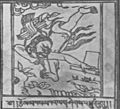Charyapada facts for kids
The Charyapada is a collection of very old songs or poems. They were written between the 8th and 12th centuries in eastern India. These special songs are part of a Buddhist tradition called Vajrayana. They are sometimes called caryagiti, which means "songs of conduct." The Charyapada were created to be sung, often during spiritual practices.
A handwritten copy of these songs was discovered in the early 1900s. This discovery was very important! It showed early forms of several languages. These include Assamese, Oriya, Maithili, and Bengali. The people who wrote the Charyapada came from different areas. These areas are now known as Assam, Bengal, Odisha, and Bihar. A copy of the Charyapada was also translated into Tibetan. This translation was kept in the Tibetan Buddhist canon, which is a collection of important Buddhist texts.
What is the Charyapada?
The Charyapada are like ancient, mystical poems. They come from a spiritual practice called the tantric tradition. These songs are not just simple tunes. They have deep, hidden meanings about spiritual journeys and understanding the world. Each song was meant to guide people on their path to wisdom.
A Special Discovery
Finding the Charyapada manuscript was a big deal for historians and language experts. It was like finding a time capsule! Before this, we didn't have many examples of these early languages. The manuscript helped us understand how languages like Bengali and Assamese developed over hundreds of years. It showed how words and grammar changed.
Who Wrote These Songs?
The poets who wrote the Charyapada were called Siddhacharyas. They were wise teachers and spiritual leaders. These poets lived in different parts of eastern India. Their songs often used everyday things to explain complex spiritual ideas. For example, they might talk about a boat or a tree to describe a journey of the mind.
Images for kids


